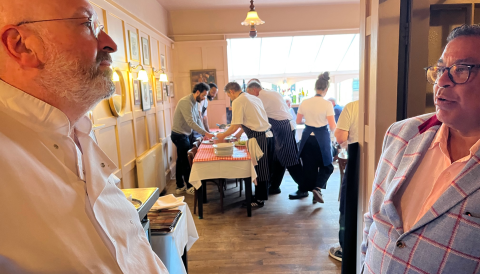Recently, while looking over a menu in a restaurant, Jancis asked me a question that I could not answer.
‘What’, she asked in all innocence, ‘has happened to all the other sorts of cabbage? It can’t all be hispi.’
She was right, as usual. On menus in the UK today hispi is offered in first courses, is stipulated in main courses, and offered as a vegetable on its own as a side dish. Hispi is also the name given to a restaurant (creators of the dish pictured above) in Didsbury, the suburb in south Manchester where I grew up. The only category that hispi is not offered in seems to be desserts. For how long, I wondered?
Help was, happily, close by. Vernon Mascarenhas has been a friend since he owned Cucina restaurant in South End Green, Hampstead. Since selling it he has cut his own path, working as the person that keen chefs go to for their fruit and vegetables. He has also provided me with information as to when the seasonal fruit and vegetables will first appear and, equally importantly, when their season will finish.
In this photograph he is informing Henry Harris (left), chef and owner of the excellent Bouchon Racine in London’s Farringdon, that he can expect the first gooseberries of the season at the beginning of the following week.
As for my vital cabbage question, Mascarenhas began by explaining there are three principal varieties. ‘Savoy cabbage is the one you will see most commonly in France and is by far the most recognisable. Then there is the January cabbage which, as its name suggests, appears in January, February and March and is the darkest green from all the nutrients it collects from growing in the colder months. And then there is what chefs refer to today as hispi but has long been known as sweetheart or pointed cabbage, because its flesh is the sweetest.’
‘And how and why has hispi cabbage become ubiquitous, in the UK anyway’, I asked. ‘The beginning goes back to chefs discovering their enthusiasm for grilling over an open fire. They started with meat and fish and then started looking around for suitable vegetables to grill and somebody must have spotted the sweetheart cabbage. It can be quartered and then grilled, and most unusually its leaves stay open so that each leaf can be coated with whatever dressing the chef is using. The great advantage of the hispi is that it can so easily be grilled: it takes on colour, it stays firm, and is extremely flexible.’
I asked him to suggest a chef who had used hispi regularly and whose cooking style I would admire. He immediately suggested Tom Pemberton, the chef-proprietor of Hereford Road restaurant in west London, who has been plying his trade most successfully through thick and thin for 16 years.
When I later asked Pemberton why hispi had become the one and only cabbage in UK restaurants, he acted as though this was the first time he had actually stopped to consider it, despite the fact that he had to admit that a great deal of hispi cabbage had passed through his kitchen over the years. And he reported that, ‘often slightly abashed customers will say “thanks for the meal, it was lovely. And I know this may sound funny, but my favourite thing was the hispi cabbage”.’
He went on to suggest that hispi’s ubiquity can be explained by its versatility, ‘near all-year-round availability’ (Portugal grows a lot of it) and ease of preparation. On top of all these factors, there’s no waste with hispi cabbages and they remain relatively cheap.
‘The word hispi some say describes the gap between each layer of leaves. If quartered or halved, and braised or grilled, this allows the edge of each layer to char or caramelise. These gaps also allow any dressing to permeate the whole of the cabbage. Its other names have helped, too. Sweetheart suggests the essential sweetness of this brassica – an attribute that becomes particularly noticeable when it is boiled or steamed and it’s paired with butter and pepper or it’s served to offset the savouriness of an anchovy dressing. Pointed refers to its shape and compactness, which allows it to stay together when grilled or braised. It’s also usually a very good size to halve, or to quarter to serve as a single serving for one.
‘All these reasons, I think, explain why hispi has been in the ascendancy for chefs and has been for the past 15 years or so. When I began cooking in the mid 1990s, the most popular cabbage was the savoy, which was regularly braised with bacon, plain boiled, or used to wrap forcemeat or to line terrines. However, savoy seemed more seasonal and it needed quite a lot of prep. It is also less homogeneous: the outer leaves were invariably too green and coarse, even to use as a wrapping. Consequently, there was more waste.
‘The savoy cabbage was also possibly viewed as more French, more traditional, and there has been a massive move away from that particular style. The increasing popularity of grilling and scorching vegetables has definitely been one reason for hispi’s growing popularity. Here we char it and pair it with a fatty Blythburgh pork chop and a mustard dressing. In lots of restaurants across London over the past 20 years there has been a move towards simplicity and hispi cabbage is a vegetable that can shine with limited adornment. And all this helps when there is a shortage of chefs, so the preparation time is limited too.
‘Another more universal reason for the seeming omnipresence of certain ingredients over the last decade or so is that more and more chefs can see what other chefs are doing through Instagram, YouTube, Vero and so on. Something visually exciting like a flaming wedge of cabbage on a wood grill with a dressing being poured over it in a New York restaurant is viewed thousands of times on the web by young cooks and ends up on lots of menus. And once an item is on the menu, if it proves popular with our customers, in spite of today’s fast-moving trends, it tends to stay.’
What began with one chef’s experimentation has continued because it tastes so good. And it is also, it transpires, good for the environment. As Mascarenhas, whose working motto is ‘root to flower eating’, explains, ‘to grow, hispi cabbages require far less ground space than savoy because they grow straight up rather than ballooning, so we can get 14 to 16 hispis in a case that will accommodate only six to eight savoys.’
If only someone could create an edible hispi crème brûlée …
Cabbage picture courtesy of Elite Bistros, of which Didsbury's Hispi is one.
What wine to drink with hispi cabbage? It depends on the preparation of course, but you might start by searching for Grüner Veltliner or Albariño among the 240,000+ wine recommendations in our tasting-note database, or check out the ideas in Tam’s Hospo pairings.














